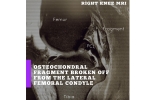What is an OCD lesion?

What is an OCD lesion?
Osteochondritis Dissecans (OCD) falls under the umbrella of an osteochondral defect. OCD lesions are abnormal bone that lies underneath an area of normal cartilage. It commonly occurs in the knee joint.
OCD lesions often become symptomatic around the second or third decade of life. We do not know why these OCD lesions occur, but it is possible they occur secondary to a microtrauma while in utero.
Signs & Symptoms
- Pain with weightbearing or impact activities (walking, running, jumping)
- Knee swelling or effusions
- Catching sensation or locking in the knee
- Feeling of the knee giving way
- Loss of range of motion of the knee
Diagnosis of an OCD lesion
In addition to the physician's clinical exam, X-Ray and MRI are the primary imaging modalities utilized to detect the size and depth of the OCD lesion.
How are OCD lesions treated?
The type of treatment - non-operative versus surgical - is based on many patient factors not limited to patient age, lesion size/depth, and activity level.
Non-surgical Treatment:
- The mainstayss include activity modification, rest, anti-inflammatories, ice and physical therapy
Surgical Management:
Surgical treatment for OCD lesions may involve knee arthroscopy to debride (clean up) the cartilage or smooth it, remove any loose bodies, microfracture, lesion fixation, Osteochondral Allograft Transplantation, MACI – Matrix Associated Autologous Chondrocyte Implantation, and/or biologic injections.







